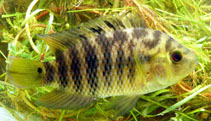| Family: |
Cichlidae (Cichlids), subfamily: Cichlinae |
| Max. size: |
19.3 cm SL (male/unsexed); max. reported age: 10 years |
| Environment: |
benthopelagic; freshwater; pH range: 6.5 - 7; dH range: 5 - 12 |
| Distribution: |
South America: Coastal drainages of Uruguay and Rio Grande do Sul, Brazil; Paraná River basin, lower part of Paraná River in Argentina. |
| Diagnosis: |
Dorsal spines (total): 15-17; Dorsal soft rays (total): 9-11; Anal spines: 5-7; Anal soft rays: 7-9. This species differs from its congeners in having a lower jaw longer than upper and mouth pointing upwards; has the shortest dorsal scale cover and the least scaled dorsal and anal fins among (together with A. tembe); with four abdominal bars (present in more than 80% of individuals as compared to 50% or less in all other species (Ref. 74689). |
| Biology: |
An opportunistic diurnal feeder, eating detritus and plant material, preying on small aquatic animals, including small fish. Very resistant to low temperatures. (Ref. 59043). Common in creeks, rivers, swamps and lakes (Ref. 74689). This species is an easy open spawner that lays its eggs on a stone or piece of wood (Ref. 12251). Both parents care for the eggs and fry (Ref. 12251). Consumed locally. Reported to reach 25.0 cm SL (Ref. 59043). |
| IUCN Red List Status: |
Least Concern (LC); Date assessed: 18 February 2021 Ref. (130435)
|
| Threat to humans: |
harmless |
Source and more info: www.fishbase.org. For personal, classroom, and other internal use only. Not for publication.

